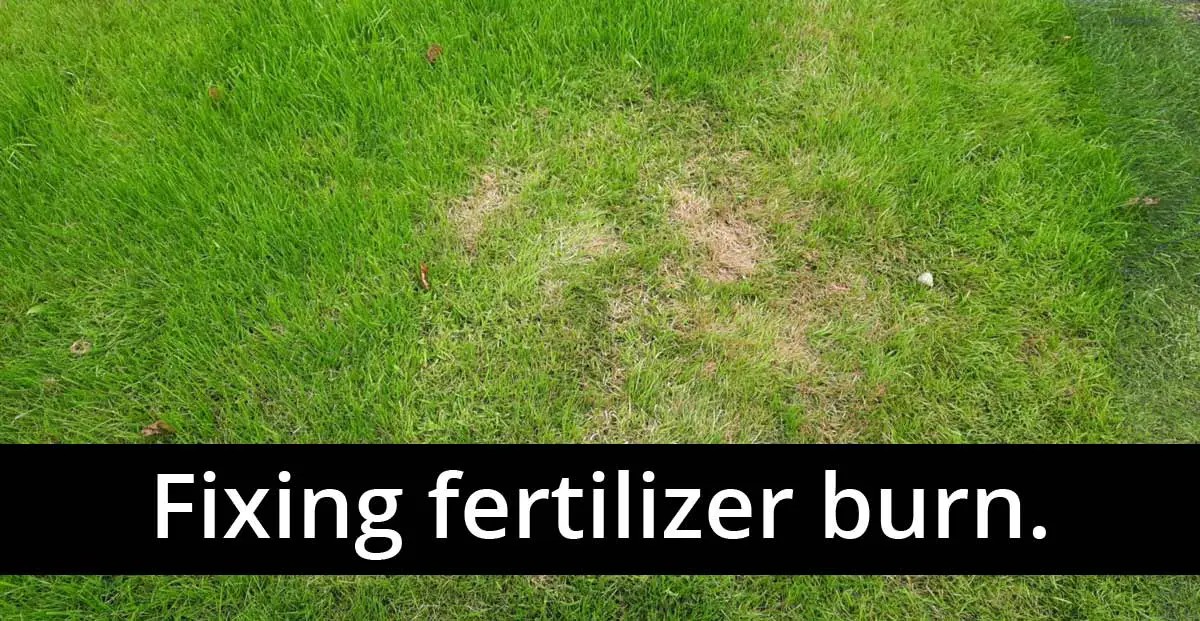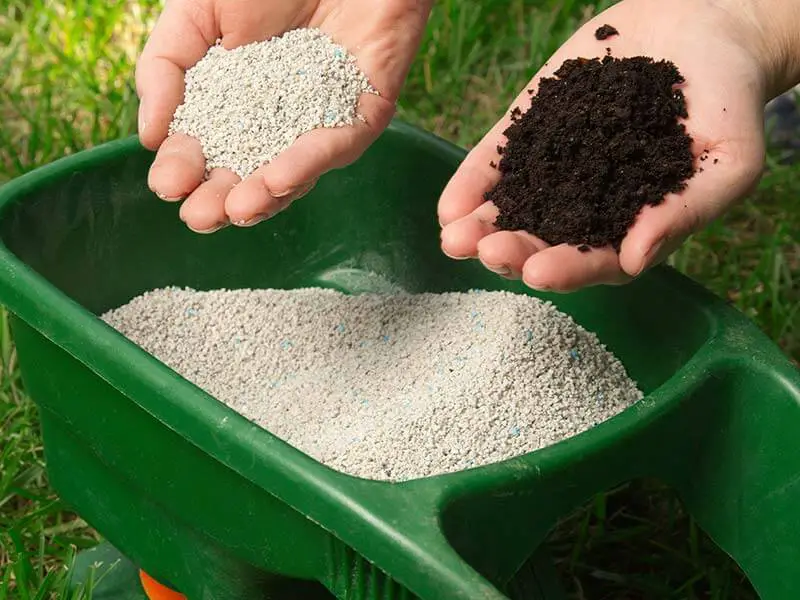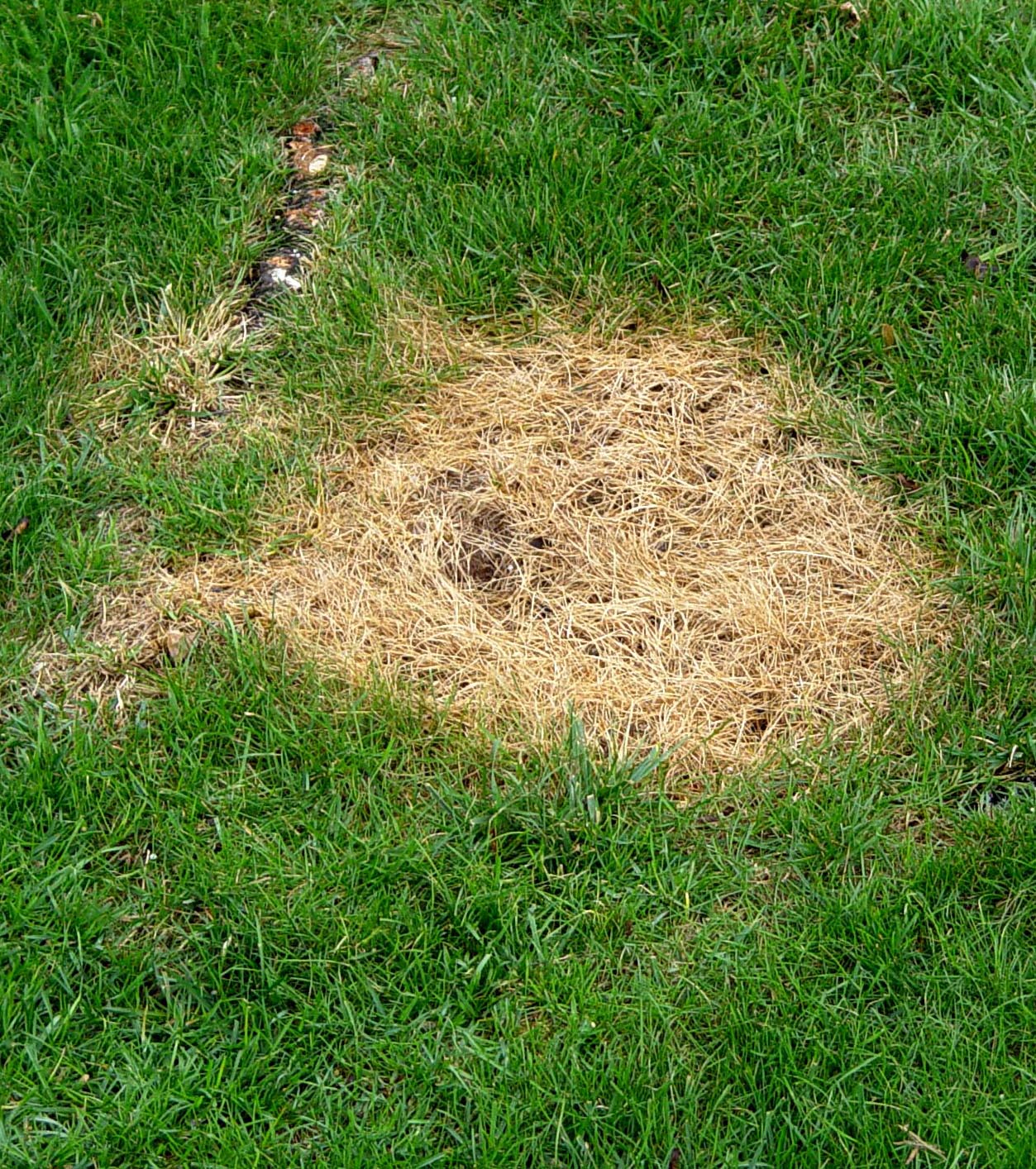Till And Rake The Burnt Areas
As your lawn cant recovery, you should throw them away. First, rake your burnt yard. Raking is a very effective scientific method, it will help you take away burnt grass and retain some lush roots.
After raking yet, you should continue to till land right after. Why? Because tilling the affected areas will help the soil become more porous, easier to absorb nutrients. Also, when grown on porous soil, grass will absorb water more efficiently.
Remember to collect the dead grass to discard and dont leave it on the land as it makes new seeds hard to grow.
How To Fix Fertilizer Burns In Grass
Grass that has been dried out due to excess fertilizer can often be revived by daily watering until the grass begins to green again. In severe cases, fertilizer overload can kill patches of grass. In this case, the dead grass must be removed, along with overfertilized topsoil. Then, new topsoil should be added and grass seed spread in the area.
Question: How Do I Fix My Burnt Lawn
I sent this question in June 2018 by a concerned lawn owner. It is a common question which I am asked a lot.
Hi Kris,
A couple of weeks ago I bought a 3 in 1 weed, feed and moss control lawn treatment from the local garden centre. I tried to apply it as per the instructions. However, I havent applied it well and it has burnt the lawn in several places. There are also dark stripes over the lawn.
How can I fix this? Thanks.
Donald
Hi Donald,
Thanks for your question. If DIY lawn weed and feed was a good quality product which was easy to apply then I would be out of a job! It is one of the most common lawn complaints I encounter from new customers.
Don’t Miss: Murray Lawn Mower Serial Number
Using Grass Clippings As A Nitrogen Fertilizer
The easiest, least expensive, and safest way to add nitrogen to your lawn is to let your grass clippings do all the work.
Instead of bagging your grass clippings, allow them to fall onto your lawn when you mow.
Grass clippings are naturally rich in nitrogen, and it is released into the soil, along with other nutrients, as decomposition takes place.
Grass clippings do not need to be watered in to be effective, and they usually decompose completely within 2-3 weeks, depending on weather conditions.
Use a rake to evenly spread the grass clippings across your lawn to avoid clumping.
Unlike synthetic nitrogen fertilizers, grass clippings release their nitrogen slowly and prevent the risk of lawn burns.
Maintain And Observe Your New Grass

Whether you are re-soding or reseeding your lawn, constantly care for it to help the grass adapt quickly to the new environment.
The first thing you need to do after planting is watering adequately. Do it daily until the roots have been established properly. After that, you can aim at watering twice or thrice a week.
Dont forget to apply fertilizer, but make sure to do it right this time round to avoid over-fertilizing. The baby grass will need starter fertilizer 2 to 3 weeks after planting.
One more thing! Wait for the grass to reach at least 3 inches high before mowing. Trimming your new grass will help it grow quickly, but doing it before the grass gets to a proper height may easily kill it.
Recommended Reading: Does Lowes Rent Riding Lawn Mowers
How Much Should I Water My Lawn After Fertilizing
How much fertilizer you need is directly impacted by your watering schedule. The more you water your lawn, the more fertilizer it will need. As the grass grows, it uses more nutrients. If you have an automatic sprinkler system, you should fertilize your lawn about every six weeks. You dont want the watering to outpace the fertilizing as that could negatively impact the lawns growth cycle. If you dont have a sprinkler system, you can wait an additional two weeks between applications. Also, be sure to carefully read the fertilizer label to learn whether you should water the lawn before or after applying the product. Granulated fertilizers need moisture to break down after application, while other fertilizers require you to soak the lawn beforehand.
Step : Water And Maintain
New grass seed and sod both need to be watered well in order to get started. Water sod daily and well to help get the roots growing and to keep them from drying out as water will initially leach through new sod pretty quickly.
New grass should be spread on well watered soils, and then kept constantly moist until new growth is at least a week old. Wait until your new grass, whether it be sod or seeded, is about three inches high until you cut it.
What to Remember:
Cut your new grass high to help it establish deep roots, and leave the cuttings to help keep the ground moist and provide natural nutrients to the newly growing vegetation.
Don’t Miss: How To Keep Lawn Green In Summer
What Is The Best Lawn Fertilizer For Early Spring
A longer-lasting fertilizer is typically healthier for your lawn in the spring, since it requires fewer applications. Nitrogen is the most important nutrient, but keep in mind that there are fast-release and controlled-release nitrogen sources. To check what the fertilizer contains, just look in the guaranteed analysis section on the back of the bag. Key terms to look for include controlled-release, slow-release, slowly-available, or water-insoluble nitrogen. Some specific types that may be listed include ureaform, sulfur-coated urea, polymer-coated urea, and IBDU . Several organic nitrogen sources are controlled-release if you prefer a more natural, less artificial choice. Most quality lawn fertilizers offer a balance of fast and controlled release sources to offer a fertilizer that will provide some quick color and some long-lasting nitrogen.
How To Get Burnt Grass Green Again
In Lawn & Garden by JamieFebruary 2, 2021
So youve got a brown grass problem in the middle of your beautiful, lush lawn, and youre pulling your hair out. Is your lawn dead? Is it beyond repair? Dont worry, theres a good chance you can save it.
To get your burnt grass green again, figure out what caused the burn. Fertilizer/urine burns can be treated with shallow waterings to remove the excess nitrogen and salt. Heat and fire burns require regular deep waterings. If the grass is completely dead, then you need to reseed.
Contents
Also Check: How To Kill Wild Violet Weeds In Lawn
Will Burnt Grass Bounce Back After Watering
Sometimes, the grass can bounce back after enough watering. However, if you are like me, then you probably just want to fix the issue as soon as possible. Furthermore, it can be difficult to figure out if a patch suffering from fertilizer burn will actually rebound or not.
My advice on this is simple. If a large part of your lawn has been scorched, then you should probably continue to water it and hope that it repairs itself. However, if it is a relatively small size, then you should probably just get to work on repairing the spot and replanting some new grass seed.
Either way, you still need to soak the patch with water for a few days. This is because you will need to flush the fertilizer out of the soil before you plant anything.
Symptoms Of Fertilizer Burn
Fertilizer burn varies by severity, but it always has roughly the same symptom: discoloration.
Mild fertilizer burn is when your lawn starts to yellow slightly or has brown streaks through it. When you touch mildly overfertilized grass, itll still feel flexible and wont break when you bend a grass blade.
With severe fertilizer burn, the grass will turn a shade of brown or tan. In severely overfertilized grass, the blades also become brittle and break if you attempt to bend them.
Also Check: How Much To Pay Teenager To Mow Lawn
What Does Nitrogen Do For Grass Should You Add It
To maintain a healthy lawn, it is important to fertilize your grass regularly.
The three main nutrients in lawn fertilizers are nitrogen, potassium, and phosphorus.
Nitrogen is considered an essential nutrient for your lawn, so what does it do for your grass?
Do you need to add it to your lawn maintenance routine?
Nitrogen is an essential element of chlorophyll, which gives grass its vibrant green color. Grass growth is also accelerated with a nitrogen-rich fertilizer. If your grass is not green and does not seem to be growing, adding nitrogen to your lawn is the best solution.
Using a nitrogen fertilizer on your lawn is easy to do, and within a few weeks, your grass will be lush and green.
Since nitrogen is such a key nutrient for your lawn, it is crucial to understand how to use it correctly.
Keep reading to learn more about what nitrogen does for grass and how to safely apply it to your lawn.
Will Grass Grow Back After Fertilizer Burn

Yes. Grass should start to regrow in about 1-2 weeks after a fertilizer burn. Grass usually grow back after fertilizer burn if the degree of damage doesnt cause a lot of discoloration and scorched leaves on the plant. However, in some cases, it may be difficult to revive the lawn or the damage may not be completely repaired for several months.
Fertilizer burn is when the area around your grass turns brown because you have either overapplied or misused a lawn fertilizer.
For example, if you apply too much fertilizer in one spot, the grass in that location will turn brown. If its just an isolated event, then theres no need to be concerned about how long it takes for the effect to wear off because it wont last forever.
The best course of action is to allow time and nature to take their course. In many cases, the grass will green up again on its own without any help from you.
This can take anywhere from one day up to four weeks depending on how much fertilizer was applied and how bad the burn was.
If you continue feeding your lawn at this point it could cause more stress on an already weak plant thats just trying to recover from a burn.
However, if this happens over and over again , chances are good that something else is causing it other than applying too much fertilizer .
Perhaps your grass is receiving too much sunlight in that location or perhaps your irrigation system isnt keeping that section of grass as well hydrated as the rest of your lawn.
Also Check: How Much Lime To Put On Lawn
Consider The Below Items To Avoid Fertilizer Burn On Your Lawn:
Fertilizer burn is a condition that can be very well-avoided by caution and enough knowledge. So arm yourself with pertinent information and fertilize carefully!
Ready to fertilize your lawn? Shop for appropriate products at Fertilizers for LESS Now!
Adsense
The Cause Of Fertilizer Burn
Fertilizer burn is always a result of overfertilization and is generally the result of fertilizing at too high a rate, applying the fertilizer unevenly or accidentally spilling fertilizer in an area.
So, why does something healthy for your lawn cause damage if you apply too much? Fertilizer is more than just nitrogen, phosphorus, and potassium. It also has mineral salts that absorb into the soil.
When you apply too much fertilizer, the salts draw moisture from the grass, resulting in discoloration and, in severe cases, death.
Also Check: Where Is Cub Cadet Manufactured
How To Fix A Lawn You Burnt With Fertilizer
Related Articles
You may know the typical signs of a new homeowner making his way down an unfamiliar learning curve: pictures that hang unevenly, bare splotches on a newly painted wall and a jerry-rigged water pipe that breaks apart in the middle of the night. Burning a lawn with grass fertilizer belongs in the same category. These missteps are easily fixed, which may come as a surprise because a burnt lawn can look especially egregious. Perhaps it all evens out in the end because if you cant fix burnt grass, you can replace it, and no one will ever be the wiser about the gardening curve you’ve learned to navigate.
Nitrogen Creates A Lush Lawn
In addition to making grass grow faster, nitrogen also helps grass grow thicker.
Bunch grasses will grow more densely, and creeping grasses will cover the ground evenly, giving your lawn a more lush appearance.
A densely-grown lawn also works to suppress weed growth naturally.
An overgrowth of weeds on your lawn is very difficult to remedy without causing harm to any nearby grass.
Pesticides cannot distinguish between weeds and healthy grass, so they must be applied carefully.
It is much safer and easier to prevent weed growth by adding nitrogen to create a more lush, full lawn.
With the right amount of nitrogen, your grass will grow tall and thick for the entire growing season.
Read Also: Where Are Cub Cadet Tractors Made
Can I Put Too Much Fertilizer On My Lawn
There is the idea of too much of a good thing, and that definitely applies when it comes to fertilizing your lawn! Applying too much fertilizer to your lawn will cause the nitrogen and salt levels in the soil to increase rapidly, which can damage or even kill the grass. When this happens, it is known as fertilizer burn and looks like yellow and brown strips or patches of dead grass. These symptoms can appear as soon as the day after a fertilizer application, making it easy to determine the cause.
How Can You Tell If Your Lawn Has Fertilizer Burns
Fertilizer burns are characterized by patches of grass in a recently fertilized lawn that appears yellow or brown. These burns can appear 1-2 days after fertilizer application but may take as long as 2 weeks to appear. After fertilization, water your lawn regularly and monitor grass conditions.
- Fertilizer burns may appear in as little as 1 day or up to 2 weeks after you spread fertilizer.
- Burns appear as yellow or brown patches of grass in your lawn.
- Grass burned by fertilizer may take on a streaky appearance and will be dry.
Grass that seems dry, brittle, or begins to show streaks of yellow or brown after fertilization is probably suffering from fertilizer burns. If this happens, begin daily watering of the affected area immediately.
Don’t Miss: How Much Is Trugreen Lawn Service
High Grass Scorch Risk
This effect is increased when using combined grass weed and feed fertilisers. By their nature they are a very fine granular or powder product to enable good contact of weed killer and weed leaf. This fine quality increases the contact area with the grass leaves therefore increasing scorch potential. Secondly if the lawn fertiliser is quick release then it is all active and has even more burn potential.
In addition, any fertiliser containing iron will also have a greater burn risk e.g. 4 in 1. This is not to say iron is a bad thing but when combined with other salts the total package is more aggressive.
Inspect Your Roots Again

In most instances, watering will help fix your over-fertilized lawn. You should be able to see new growth after 7 to 14 days of watering. If nothing changes after this period, its time to reinspect the roots.
Check to see if there are new grassroots. If there are, then you have successfully solved your problem. If nothing has happened, the damage is beyond repair and the only thing you can do now is planting new grass.
Don’t Miss: How Much Is Trugreen Lawn Service
How To Avoid Garden And Lawn Fertilizer Burn
You may have seen it happen in your own yard or a neighbor’s. Shortly after a fertilizer application, lawn grasses or garden plants start to discolor and look scorched from “fertilizer burn.” Depending on the damage, plants may bounce back or not. By taking steps to understand this common, preventable problem, you can fertilize your lawn and garden and avoid fertilizer burn:
Should I Fertilize My Lawn Before Or After Mowing
Ideally, youll want to mow and rake before fertilizing so that excess lawn waste is removed, allowing the fertilizer to have an easier time reaching the soil. Aerating your soil before fertilizing can also help. When fertilizing a lawn, it is best to apply fertilizer after the lawn has been mowed so it has a few days to absorb the fertilizer.
Recommended Reading: What Is The Best Lawn Chair
Minimal Grass Scorch Risk
On the other hand the salts in controlled or slow release fertilisers are locked up to a certain degree thus limiting the dangers. Secondly, fertilisers such as Lawnsmith® Fertilisers are granules or pellets that will bounce or roll off the leaf into the soil thus minimising the amount of fertiliser contacting the grass leaf. This considerably reduces burn or scorch potential.
